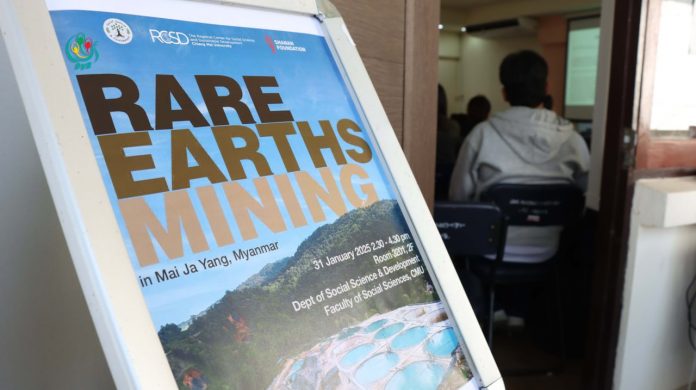Guest contributor
James Shwe
Myanmar’s rare earth elements (REEs), particularly heavy rare earth elements (HREEs) like dysprosium and terbium, have become a focal point in global supply chains for green technologies and defense systems.
Controlled primarily by the Kachin Independence Organization (KIO) and resistance-aligned groups, these resources hold both promise and peril for Myanmar’s democratic movement.
While their strategic value is undeniable, leveraging them for international support-particularly from the U.S.-requires navigating complex geopolitical, environmental, and governance challenges.
Here, we examine the realities of Myanmar’s REE sector, the limitations of replicating models like the U.S.-Ukraine minerals pact, and constructive steps for the National Unity Government (NUG) and ethnic resistance organizations (EROs) to maximize their impact.
The strategic importance of Myanmar’s rare earths
Global demand and China’s reliance
Myanmar supplies 40 percent of the world’s HREEs, critical for electric vehicle (EV) motors, wind turbines, and advanced defense technologies.
China, which processes 90 percent of global REEs, depends on Myanmar for 57 percent of its imports-a vulnerability exposed when KIO export restrictions in late 2024 caused dysprosium prices to surge by 210 percent.
This dependency underscores Myanmar’s latent leverage, but it also ties the sector inextricably to Chinese infrastructure and markets.
Revenue for resistance and local governance
The KIO has imposed a tax of 35,000 yuan ($4,800 USD) per ton on REE exports, channeling funds into local infrastructure, healthcare, and education in resistance-held areas.
In 2023 alone, Myanmar’s REE trade with China reached $1.4 billion USD, with post-coup exports exceeding $3.6 billion USD.
These revenues, while vital, highlight the tension between short-term survival and long-term sustainability.
Why Myanmar’s REEs cannot replicate the U.S.-Ukraine model
Structural Barriers
- Lack of recognition: Unlike Ukraine, a sovereign state with formal mining laws, the NUG and KIO lack international recognition, complicating binding agreements with the U.S.
- China’s processing monopoly: Even if exports were diverted, the U.S. lacks sufficient refining capacity for HREEs. China’s control over 85 percent of global processing ensures Myanmar’s REEs remain bottlenecked.
- U.S. domestic priorities: The U.S. is investing heavily in projects like Wyoming’s Halleck Creek (2.63 billion tonnes of reserves) and Texas’s Round Top Mountain to achieve REE self-sufficiency by 2029.
These efforts, supported by bipartisan legislation like the Rare Earth Magnet Security Act, prioritize domestic and allied supply chains over conflict zones.
Environmental and ethical concerns
Unregulated mining in Kachin has caused catastrophic environmental damage, with toxic leaching pools contaminating waterways and displacing communities.
Reports of health crises and forced labor further deter Western engagement, which is increasingly bound by standards like the E.U.’s Critical Raw Materials Act.
Current efforts and challenges
Centralized governance and revenue allocation
The KIO exercises control over mining through a Rare Earth Management Committee, requiring permits and taxes at multiple levels. Revenue is officially earmarked for regional development, though transparency remains limited.
Satellite imagery reveals a tripling of mining sites since the 2021 coup, with over 370 sites and 2,700 leaching pits identified in Chipwi and Momauk townships.
Community engagement and environmental claims
The KIO claims to enforce “strict rules” to minimize ecological harm, canceling projects in response to local opposition. However, environmental groups report ongoing devastation, with few tangible safeguards.
Constructive pathways for the NUG and EROs
1. Strengthen regional partnerships
- Japan and South Korea: These nations import 90–97 percent of their REEs from China and have incentives to diversify. Japan’s $478 million USD REE imports in 2023 and South Korea’s $7.03 billion USD dependency on critical minerals make them viable partner.
- ASEAN Diplomacy: Highlighting China’s environmental abuses in Kachin could rally Association of Southeast Asian Nations (ASEAN) states wary of Beijing’s dominance.
2. Implement incremental reforms
- Transparency measures: Publish quarterly reports on REE revenue allocation, even if incomplete, to build trust with international stakeholders.
- Environmental mitigation: Relocate leaching pools away from waterways and partner with local NGOs for discreet monitoring.
3. Leverage tactical export controls
The KIO’s 2024 decision to restrict exports-causing terbium prices to spike-demonstrates the power of calibrated disruptions. Repeating such measures during the U.S.-China negotiations could pressure Beijing while funding humanitarian and defense needs.
4. Align with global standards
Adopt frameworks like the EU Critical Raw Materials Act to position the NUG as a responsible steward. This includes pledging future compliance with ethical sourcing benchmarks and resource federalism.
From extraction to empowerment
Myanmar’s rare earths are not a shortcut to international recognition but a component of a broader strategy. By prioritizing regional collaboration, incremental governance reforms, and tactical supply chain influence, the NUG and EROs can transform these resources into a symbol of accountable leadership.
The path forward requires balancing pragmatism with principle-acknowledging the sector’s current realities while laying the groundwork for a post-junta Myanmar where resource sovereignty and democratic values converge. Success will demand patience, but with strategic discipline, Kachin’s rare earths could yet underpin a freer future.
James Shwe is a Myanmar democracy activist in the U.S. and is a member of the advocacy groups Free Myanmar and the Los Angeles Myanmar Movement. He has been trying to organize and motivate the Myanmar diaspora to advocate for democracy in Myanmar.
DVB publishes a diversity of opinions that does not reflect DVB editorial policy. We’d like to hear what you think about this or any of our stories: [email protected]



